#lord george gordon (barnaby rudge)
Explore tagged Tumblr posts
Text
Now we've reached the end of the Dickens Daily run of Barnaby Rudge; A Tale of the Riots of 'Eighty, I feel I should recommence my series of posts on illustrations.
This is the first post which looks at part 2 (the 1780 section) of the novel.
As before, I'll group illustrations by location. Since part 2, mirroring part 1, begins at the Maypole, so shall we:
The Maypole Inn, Chigwell
Characters featured: John Willet (resident), Hugh (resident), Lord George Gordon, Mr Gashford, John Grueby, Solomon Daisy, Tom Cobb, Phil Parkes, Sim Tappertit, Ned Dennis, Rudge Senior., Mr Haredale, and various unnamed rioters
Chapters featured: 33, 35, 37, 54, 55, and 56
Illustrators featured: Phiz (Hablot Knight Browne), George Cattermole, Harry Furniss, Felix Darley, A. H. Buckland, Sol Eytinge Jr., and Fred Barnard
The Main Room at the Maypole
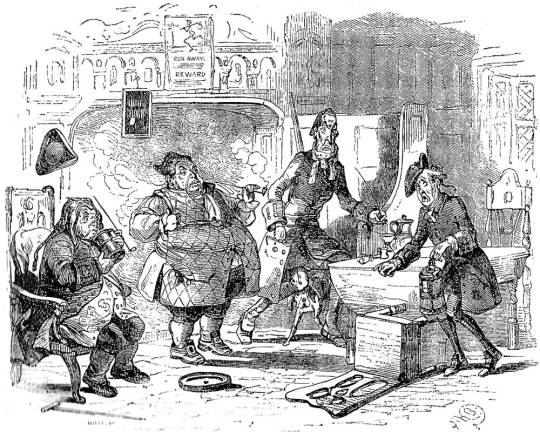
The above is by Phiz for chapter 33, the first chapter of the 1780 section of the novel. Chapter 33 takes place exactly five years after chapter 1, and twenty-seven years after the double murder at the Warren.
Chapter 1 ended with Solomon Daisy saying:
‘[...] on the nineteenth of March in some year, sooner or later, that man will be discovered.’
And in chapter 33, Solomon comes in claiming to have seen a ghost in the churchyard:
‘[...] something in the likeness of a man. It was bare-headed to the storm. It turned its face without stopping, and fixed its eyes on mine. It was a ghost—a spirit.’ ‘Whose?’ they all three cried together. In the excess of his emotion [...] his answer was lost on all but old John Willet, who happened to be seated close beside him. [...] ‘Gentlemen,’ said Mr Willet after a long pause, ‘you needn’t ask. The likeness of a murdered man. This is the nineteenth of March.’
Since chapter 33 mirrors chapter 1, Phiz's illustration uses many of the same elements as his illustration for chapter 1 (see my previous post about the Maypole for that illustration): we see the same fireplace, with a chair on the left and a settle on the right, and a table and window further right still. The scene is slightly reframed though, as there are fewer characters to fit in.
The Bar of the Maypole

By Cattermole (1841), for chapter 54.
Like Phiz, Cattermole, the serialisation's other illustrator, also reuses elements from his earlier illustration of the Bar of The Maypole (for chapter 25, in the same post about the Maypole linked above) when he revisits the scene for chapter 54, when the rioters ransack The Maypole.
John Willet is sat in the same place as he was in the earlier illustrated scene, but instead of being alone and relaxed, he watches on as his sanctuary is trashed, including by the inn's ostler Hugh, now one of the leaders of the riots.
Hugh is in the centre "the loudest, wildest, most destructive villain there" but still keeping an eye John so no harm comes to him.
I assume that's Ned Dennis on the far right, sneaking near John, and I think that's Sim Tappertit sat on the table - this isn't described in this scene, but mirrors Sim's position in Phiz's illustration of the meeting of the 'Prentice Knights for chapter 8 (see my earlier post on miscellaneous London locations for that illustration).
The rest of the rioters are unnamed, but I would just draw your attention to the man stood slightly behind and to the side of John Willet: he appears to be laughing about something he's holding over John's head - keep this in mind for the next illustration...
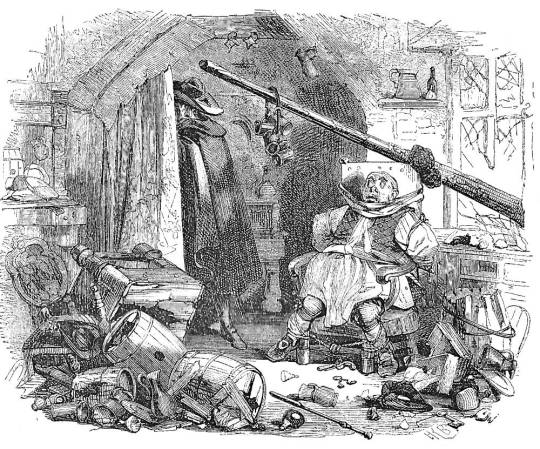
Phiz (1841) for chapter 55
Take a moment to look at John Willet in the above illustration for chapter 55, then scroll up to look again at how Phiz drew the same character in chapter 33... Then again at Cattermole's illustration for chapter 54, and at the man laughing while he holds something over John's head... Then come back to this illustration, and look at what's on the corner of the chair...
They snatched his wig!
I don't think this is mentioned anywhere in Dickens's text - but Phiz and Cattermole apparently decided between themselves that the rioters took John's wig off and put it on the corner of the chair. I wonder how and to what extent they communicated with each other about their illustrations for the original serial publication.
Phiz hadn't previously drawn the Maypole's bar, but he clearly takes influence from Cattermole in how he draws it - he uses the same type of arch as Cattermole. However, while Cattermole has a fireplace to the right of John's chair (which isn't really evident in Cattermole's illustration for chapter 54, but is in the one for chapter 25), Phiz has a window there in chapter 55, so he can show how "the Maypole peered ruefully in through the broken window, like the bowsprit of a wrecked ship".


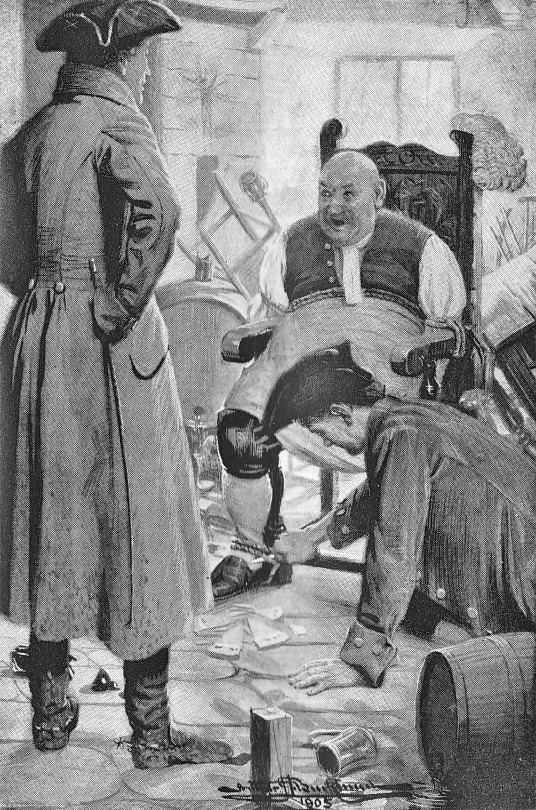
Left: Harry Furniss (1910) for chapter 55; Middle: Felix Darley (1888) for chapter 55; Right: A. H. Buckland (1900) for chapter 56
Harry Furniss and A. H. Buckland, in their twentieth century illustrations, are clearly drawing upon Phiz's illustration, having John look similar and be tied in a similar way, with his wig hung somewhere in the scene.
What they don't include, that Phiz does, is the figure of the man (who is still unnamed up to this point, but is later revealed to be Mr Rudge Senior); Furniss appears to be focusing on a part of the scene before the man enters; Buckland instead focuses on the following chapter, when Mr Haredale and Solomon Daisy free John from the chair on their way to the Warren.
Meanwhile Felix Darley doesn't pay homage to Phiz like Furniss and Buckland do, and draws the scene and John very differently. He renders a very dynamic version of the scene where Rudge Senior asks John about where the rioters have gone.
Upstairs at the Maypole
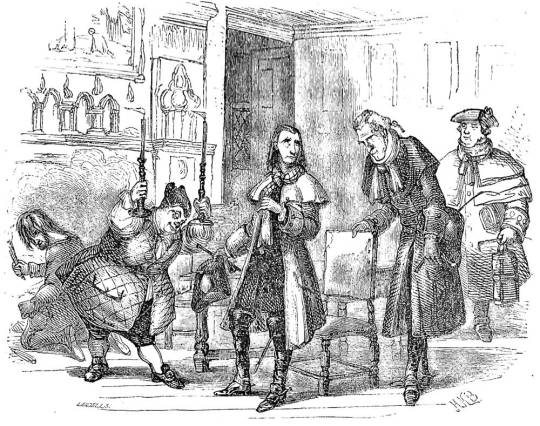

Left: Phiz (1841); Right: Sol Eytinge Jr (1867); both for chapter 35
Jumping back in time from the June riots to the March visit of Lord George Gordon, Mr Gashford, and John Grueby to the Maypole on their way to London.
I find the different ways these two illustrations tackle the same subject matter interesting: Phiz shows everyone revolving around Lord George Gordon, and shows all the other characters' differing interest in him through their body language; Eytinge, meanwhile, omits John Willet and Hugh to focus on the three new characters, and emphasises Mr Gashford' malevolent manipulation of the young politician.
Outside the Maypole

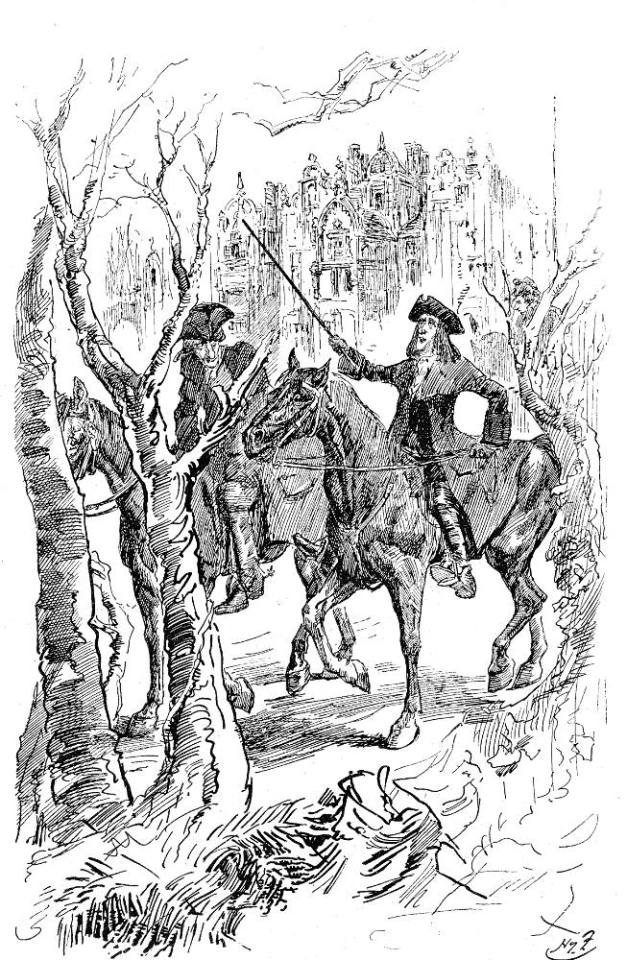
Left: Fred Barnard (1874); Right: Harry Furniss (1910); both for chapter 37, where Lord George Gordon and his retinue leave the inn.
It's interest to see how they both render the below:
[...] Sitting bolt upright upon his bony steed, with his long, straight hair, dangling about his face and fluttering in the wind; his limbs all angular and rigid, his elbows stuck out on either side ungracefully, and his whole frame jogged and shaken at every motion of his horse’s feet; a more grotesque or more ungainly figure can hardly be conceived. In lieu of whip, he carried in his hand a great gold-headed cane, as large as any footman carries in these days, and his various modes of holding this unwieldy weapon—now upright before his face like the sabre of a horse-soldier, now over his shoulder like a musket, now between his finger and thumb, but always in some uncouth and awkward fashion—contributed in no small degree to the absurdity of his appearance. Stiff, lank, and solemn, dressed in an unusual manner, and ostentatiously exhibiting—whether by design or accident—all his peculiarities of carriage, gesture, and conduct, all the qualities, natural and artificial, in which he differed from other men; he might have moved the sternest looker-on to laughter, and fully provoked the smiles and whispered jests which greeted his departure from the Maypole inn. Quite unconscious, however, of the effect he produced, he trotted on beside his secretary, talking to himself nearly all the way, until they came within a mile or two of London, when now and then some passenger went by who knew him by sight, and pointed him out to some one else, and perhaps stood looking after him, or cried in jest or earnest as it might be, ‘Hurrah Geordie! No Popery!’
#illustration#lord george gordon (barnaby rudge)#john willet#hugh (barnaby rudge)#mr haredale#mr gashford#barnaby rudge#barnaby rudge; a tale of the riots of 'eighty#dickens daily#barnaby rudge spoilers
4 notes
·
View notes
Text
Jedes kleine Licht hält sich für eine RiesenFunzel, die anderen heimleuchten kann
ScienceFiles:»" data-medium-file="https://i0.wp.com/sciencefiles.org/wp-content/uploads/2017/07/david-brooks-village-idiot.png?fit=274%2C300&ssl=1" data-large-file="https://i0.wp.com/sciencefiles.org/wp-content/uploads/2017/07/david-brooks-village-idiot.png?fit=290%2C318&ssl=1" />Barnaby Rudge, eine der schönen dicken Novellen, die Charles Dickens hinterlassen hat, ist eine bemerkenswerte Erzählung. Barnaby Rudge ist ein sehr kräftiger junger Mann, der mental etwas retardiert ist. Wie er instrumentalisiert wird, von Mr. Gashford, dem ruchlosen Sekretär mit eigener Agenda, der für den nicht minder ehrlosen Lord George Gordon die Schmutzarbeit erledigt, das […] http://dlvr.it/SM2ypH «
1 note
·
View note
Photo

Barnaby Rudge, by Charles Dickens, is a historical novel that deals with the Gordon Riots of 1780.
In 1778 the British parliament passed the Catholic Relief Act. The act replaced anti-Catholic legislation. However, it was not a universally popular change. On June 2, 1780, Lord George Gordon led a group of like-minded people to Parliament. They wanted the Catholic Relief Act repealed. Violence broke out and spread. Peace was not restored until June 9. By that time, Catholic chapels had been broken into, Newgate Prison was burned, and hundreds of people were killed.
The action picks up in Chapter 48, when Barnaby gets separated from his mother and joins the swelling mob. The rioters went from place to place, and though their main target was Newgate, they terrorised London in the process and burned this and that. The mob ransacked the Maypole Inn (this is one of the maddest scenes; Chapter 54) and burned to the ground the Haredale mansion (Chapter 55).
Excerpt: “A mob is usually a creature of very mysterious existence, particularly in a large city. Where it comes from or whither it goes, few men can tell. Assembling and dispersing with equal suddenness, it is as difficult to follow to its various sources as the sea itself; nor does the parallel stop here, for the ocean is not more fickle and uncertain, more terrible when roused, more unreasonable, or more cruel.”
0 notes
Text
The sixth of several posts about illustrations (of the 1780 section) of Charles Dickens's Barnaby Rudge.
Newgate Prison, London
Characters featured: Hugh, Ned Dennis, Barnaby Rudge, Grip, Mrs Rudge, Rudge Senior, Stagg, Mr Varden, various rioters, various prisoners, various prison officials.
Chapters featured: 58, 62, 64, 65, 74, 76, 77
Illustrators featured: Phiz, Felix Darley, Sol Eytinge Jr, Fred Barnard, Harry Furniss
Outside the Prison Walls

Phiz (1841) for chapter 64, when the mob try to threaten Gabriel Varden to show them how to force the lock of the door that he helped to make.
In vain the basket of tools was laid upon the ground before him, and he was urged in turn by promises, by blows, by offers of reward, and threats of instant death, to do the office for which they had brought him there. ‘No,’ cried the sturdy locksmith, ‘I will not!’ He had never loved his life so well as then, but nothing could move him.
When Dickens initially signed a contract for the novel that would become Barnaby Rudge; A Tale of the Riots of 'Eighty, back in the 1830s, he was intending to call it Gabriel Vardon, The Locksmith of London. Presumably in that version, Gabriel's defiance of the mob and refusal to work with them would have been even more important. I would love to know more about Dickens's development of the plot, and when he decided to change the planned novel's title to direct the audience's focus towards Barnaby rather than Mr Varden.
In the Cells

By Phiz (1841) for chapter 62, when Stagg visits his friend Rudge Senior in his cell at Newgate during his first imprisonment.


Left: Phiz (1841); Right: Sol Eytinge Jr (1867); both for chapter 74, when Ned Dennis is put in the same cell as Hugh.


Left: Phiz (1841); Right: Harry Furniss (1910); both for chapter 58, when Barnaby is first taken to Newgate.
Phiz's Barnaby appears sad and vulnerable, and the light from the window shines on him in a way which both emphasises his captivity, and hints at the religious message which will become more prominent in Barnaby's second imprisonment.
Furniss's illustration shows Barnaby lost in thought, and above him we see superimposed images: in the centre, Barnaby with the banner he was given to hold on the first day of the riots, and around him, the various figures who influenced his actions and led him to where he was now: to the right and looking up at him (possibly waving a handkerchief?) is his mother, who he wanted to save from hardship and thought would be proud of him; in the top right-hand corner is Lord George Gordon on a horse, directing him with a pointed finger; and on the left is Hugh, leading the way.


Left: Phiz (1841); Right: Felix Darley (1862); both for chapter 76 when Barnaby is imprisoned in Newgate for the second time, illustrating the following quote:
From the first his mother had never left him, save at night; and with her beside him, he was as usual contented. On this last day, he was more elated and more proud than he had been yet; and when she dropped the book she had been reading to him aloud, and fell upon his neck, he stopped in his busy task of folding a piece of crape about his hat, and wondered at her anguish. Grip uttered a feeble croak, half in encouragement, it seemed, and half in remonstrance, but he wanted heart to sustain it, and lapsed abruptly into silence.
I particularly like Darley's version of this scene: you can really see Mrs Rudges' anguish.
The Yards and Corridors of the Prison


Left: Fred Barnard (1874); Harry Furniss (1910); both for chapter 76, when the three condemned men, Barnaby, Hugh, and Dennis, are in the yard on their last night before execution.
Both artists focus on the dynamic and study in contrasts between Hugh and Dennis, with Barnaby slightly more in the background. Barnard's Barnaby is in his last embrace and separation from his mother; Furniss's Barnaby is in the immediate aftermath of this separation.

By Phiz (1841) for chapter 62, the meeting between Barnaby and his father in the prison yard, during their first imprisonment.

Phiz (1841) for chapter 65, in the corridors of the Prison. During the burning of Newgate, while the other rioters are setting free the other prisoners, Ned Dennis goes to the corridor outside the cells of the condemned men and takes pleasure in listening to their desperate pleadings to be freed.

Fred Barnard (1874) for chapter 65. I think this is meant to illustrate the following, which Rudge Senior witnesses from his cell window during the burning of Newgate:
By their legs, their arms, the hair upon their heads, they dragged the prisoners out. Some threw themselves upon the captives as they got towards the door, and tried to file away their irons; some danced about them with a frenzied joy, and rent their clothes, and were ready, as it seemed, to tear them limb from limb. Now a party of a dozen men came darting through the yard into which the murderer cast fearful glances from his darkened window; dragging a prisoner along the ground whose dress they had nearly torn from his body in their mad eagerness to set him free, and who was bleeding and senseless in their hands. Now a score of prisoners ran to and fro, who had lost themselves in the intricacies of the prison, and were so bewildered with the noise and glare that they knew not where to turn or what to do, and still cried out for help, as loudly as before. Anon some famished wretch whose theft had been a loaf of bread, or scrap of butcher’s meat, came skulking past, barefooted—going slowly away because that jail, his house, was burning; not because he had any other, or had friends to meet, or old haunts to revisit, or any liberty to gain, but liberty to starve and die. And then a knot of highwaymen went trooping by, conducted by the friends they had among the crowd, who muffled their fetters as they went along, with handkerchiefs and bands of hay, and wrapped them in coats and cloaks, and gave them drink from bottles, and held it to their lips, because of their handcuffs which there was no time to remove. All this, and Heaven knows how much more, was done amidst a noise, a hurry, and distraction, like nothing that we know of, even in our dreams; which seemed for ever on the rise, and never to decrease for the space of a single instant.
In Barnard's illustration, the 'intricacies' of the prison are lost in favour of conveying the scale and confusion of the action.
Awaiting Execution

By Phiz (1841) for chapter 77, when the condemned prisoners Barnaby, Hugh, and Dennis have had their irons struck off, prior to being taken for execution.
‘That gentleman yonder—’ pointing to the clergyman—‘has often in the last few days spoken to me of faith, and strong belief. You see what I am—more brute than man, as I have been often told—but I had faith enough to believe, and did believe as strongly as any of you gentlemen can believe anything, that this one life would be spared. See what he is!—Look at him!’ Barnaby had moved towards the door, and stood beckoning him to follow. ‘If this was not faith, and strong belief!’ cried Hugh, raising his right arm aloft, and looking upward like a savage prophet whom the near approach of Death had filled with inspiration, ‘where are they! What else should teach me—me, born as I was born, and reared as I have been reared��to hope for any mercy in this hardened, cruel, unrelenting place! Upon these human shambles, I, who never raised this hand in prayer till now, call down the wrath of God! On that black tree, of which I am the ripened fruit, I do invoke the curse of all its victims, past, and present, and to come. On the head of that man, who, in his conscience, owns me for his son, I leave the wish that he may never sicken on his bed of down, but die a violent death as I do now, and have the night-wind for his only mourner. To this I say, Amen, amen!’
#illustration#barnaby rudge#dickens daily#hugh (barnaby rudge)#ned dennis#gabriel varden#barnaby rudge (book)#barnaby rudge; a tale of the riots of 'eighty
1 note
·
View note
Text
The fifth of several posts about illustrations (of the 1780 section) of Charles Dickens's Barnaby Rudge.
London Pubs - The Boot and The Black Lion
Characters featured: Hugh, Ned Dennis, Sim Tappertit, Barnaby Rudge, Grip, Joe Willet, John Willet, Dolly Varden, various protestants, various soldiers
Chapters featured: 38, 39, 52, 72, 78
Illustrators featured: Phiz (Hablot Knight Browne), George Cattermole, Fred Barnard, Harry Furniss,
The Boot, fields to rear of the Foundling Hospital, London

By George Cattermole (1841), possibly for chapter 52. We see the exterior of The Boot, "in a manner the head-quarters of the rioters".

By Phiz (1841) for chapter 38, when Ned Dennis takes Hugh to The Boot following his enrollment in the Great Protestant Association.
Before putting his lips to the liquor which was brought for them, Dennis drank in a loud voice the health of Lord George Gordon, President of the Great Protestant Association; which toast Hugh pledged likewise, with corresponding enthusiasm. A fiddler who was present, and who appeared to act as the appointed minstrel of the company, forthwith struck up a Scotch reel; and that in tones so invigorating, that Hugh and his friend (who had both been drinking before) rose from their seats as by previous concert, and, to the great admiration of the assembled guests, performed an extemporaneous No-Popery Dance.
I don't have much to say about this illustration other than that I love the expression on Hugh's dog's face. He looks a bit concerned.



Top: Phiz (1841); Bottom Left: Phiz (1841); Bottom Right: Harry Furniss (1910); all for chapter 39. More revelry and bigotry at The Boot.
The Stable of the Boot

By Fred Barnard (1874) for chapter 52.
The Riots have now begun, and Hugh has assigned Barnaby sentry duty outside the stable of The Boot, in order to keep him occupied while the rest of the rioters plan and execute their attack on the Warren, where Barnaby's old friends and benefactors, the Haredales, live.
I really like this quiet moment between Barnaby and Grip. I also like that Grip is actually Raven size. In some illustrations, he's barely big enough to be a crow...

By Phiz (1841) for chapter 57, where Barnaby is attacked and taken.
Again there was a dead silence, and again the same voice called upon him to deliver himself up. Next moment he was back in the stable, dealing blows about him like a madman. Two of the men lay stretched at his feet: the one he had marked, dropped first—he had a thought for that, even in the hot blood and hurry of the struggle. Another blow—another! Down, mastered, wounded in the breast by a heavy blow from the butt-end of a gun (he saw the weapon in the act of falling)—breathless—and a prisoner.
The Black Lion, Whitechapel, London


Left: Furniss (1910) possibly for chapter 72 when we (and John Willet) are told where Joe has been for the last five years and how he lost his arm; Right: Fred Barnard for chapter 72 when Joe and Dolly talk, the same night that Dolly and Emma were rescued.


Left: Phiz (1841); Right: Furniss (1910); both for chapter 78 when Joe and Dolly admit their feelings for each other and try to speak to John Willet about it.
#illustration#barnaby rudge#barnaby rudge (book)#barnaby rudge; a tale of the riots of 'eighty#dickens daily#joe willet#dolly varden#hugh (barnaby rudge)#scheduled
1 note
·
View note
Text
#this is the first I'm learning about the real edward dennis! #op do you know how to find out more? google isn't being very helpful #barnaby rudge #barnaby rudge reactions tags from @dickensdaily
Yeah, there's not much in terms of webpages actually about Edward Dennis - he doesn't have a wikipedia page or anything - but there's bits and pieces scattered about on pages about other things which I managed to scavenge up a little while ago.
I've collected below some links - the reliability of these sources varies, so obviously use your own judgement in how much you trust the information:
[There are various references to "Jack Ketch" when talking about Dennis. Jack Ketch was the name of a seventeenth century executioner who became particularly famous, and by the eighteenth and nineteenth centuries his name was used as a way of referring to an executioner - which is why Edward Dennis is sometimes referred to in ways like "better known by the name of Jack Ketch" despite Jack Ketch being a whole other guy from like a hundred years before.]
Primary Sources:
The Proceedings of the Old Bailey, sessions paper for 28th June 1780
[The webpage is somewhat oddly formatted... in good news, scanned pages of the published sessions paper are on the left and text on the right; in bad news, all the content is scrunched into the top tenth of the page and then there's a huge blank space below, so it's difficult to scroll through. If you CTRL+F "Edward Dennis" there are two results: the first is the report of his trial, and the second in the sentencing section near the end of the text. It's also worth scrolling down a bit more from the sentencing section to see where the people sentenced were executed; Dennis is not mentioned in that section by name so would presumably be included in the sentence "(The execution of the remainder of the convicts was respited during his Majesty's pleasure.)"]
[Unrelated to Ned Dennis, but: while you're looking at the session paper, you may be interested to look for mentions of 'insanity' and 'madness' and 'idiot' - there are several, in the reports of trials for several different people; some were found guilty, some not guilty. If Dickens looked at the proceedings of the Old Bailey in his research, he wouldn't have had to look far to find inspiration for Barnaby.]
The Gentleman's Magazine And Historical Chronical July 1780 issue, which is p. 343 (#371) of what appears to be an annual for the year 1780
[The first full paragraph on p.343 is about "Edw. Dennis"]
Other sources of info
Newgate and Old Bailey timeline [Edward Dennis mentioned twice: 1771 and 1780]
List of UK Executioners at liquisearch [Has an entry; also mentioned in relation to his successor William Brunskill]
The entry for 'Lord George Gordon' in the Newgate Calendar, reproduced on The Ex-Classics website [The last paragraph mentions Ned Dennis. n.b. I think the Newgate Calendar was somewhat sensationalised, so possibly not the most reliable source]
Newgate Prison page on Wikinut [Dennis has a section. n.b. as far as I can tell wikinut is essentially just blog posts so again, I'm unsure of the reliability]
Various pages on capitalpunishmentuk:
List of 'Early English hangmen' [there's a paragraph about Edward Dennis]
Page about 'Charlotte Gardiner and Mary Roberts - Two of the Gordon Rioters' [there's a paragraph about Dennis; and mention of Dennis in a paragraph about how he was probably not the one who executed those executed at Tower Hill, then a list of other places the rioters were executed]
Timeline [Dennis mentioned in relation to ''the New Drop' at Newgate in 1783, so a few years after the riots]
The history of judicial hanging in Britain 1735 - 1964 [Dennis mentioned when talking about 'the New Drop']
Newgate Prison on Wikipedia [No mention of Dennis, but the 'Executions' section appears to corroborate in other matters some of the other sources here such as wikinut and capitalpunishmentuk, which increases my faith in their reliability somewhat]
Charles Dickens, finding out the real Ned Dennis was reprieved: FUCK THAT *works him off*
#edward dennis#ned dennis#barnaby rudge; a tale of the riots of 'eighty#barnaby rudge (book)#death mention#death penalty mention#death penalty#violence mention
6 notes
·
View notes